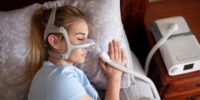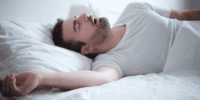How to Address Restless Leg Syndrome for Peaceful Sleep

Restless Leg Syndrome (RLS) is a neurological disorder characterized by an irresistible urge to move the legs, often accompanied by uncomfortable sensations. This article aims to provide an overview of strategies for addressing RLS and promoting peaceful sleep.
By examining common symptoms, discussing lifestyle changes, exploring natural remedies, and considering medical interventions, individuals suffering from RLS can gain knowledge and insight into managing their condition effectively.
Furthermore, tips for improving sleep quality while dealing with RLS will be presented.
Key Takeaways
- Restless Leg Syndrome is a neurological disorder characterized by an irresistible urge to move the legs and is often accompanied by uncomfortable sensations.
- Lifestyle changes such as exercise, modifying the sleep environment, adopting a healthy diet, and incorporating supplements like iron and magnesium can help manage Restless Leg Syndrome and improve sleep quality.
- Regular physical activity, including aerobic exercise, resistance training, and yoga, has been shown to reduce RLS severity and improve sleep quality.
- Other approaches for addressing Restless Leg Syndrome include sleep environment modifications, diet and supplements, natural remedies and home treatments, and medical interventions such as dopamine agonists and GABA-increasing medications.
Understanding Restless Leg Syndrome
Restless Leg Syndrome is a neurologic disorder characterized by an overwhelming urge to move the legs, often accompanied by uncomfortable sensations. The exact causes of restless leg syndrome remain unclear, but several factors have been identified as potential contributors.
One possible cause is an imbalance in dopamine levels, a neurotransmitter that plays a role in muscle movement. Iron deficiency has also been linked to the development of restless leg syndrome, as iron is essential for dopamine production. Other factors that may contribute to the condition include genetics, certain medications, and certain medical conditions such as kidney failure.
When it comes to treatment options, there is no cure for restless leg syndrome, but several strategies can help manage the symptoms. Lifestyle changes such as regular exercise, avoiding caffeine and alcohol, and practicing good sleep hygiene can be beneficial. Medications such as dopamine agonists, opioids, and anticonvulsants may also be prescribed to alleviate symptoms. Additionally, certain non-pharmacological treatments like massage, heat or cold therapy, and relaxation techniques have shown promise in providing relief.
Further research is needed to fully understand the causes and develop more effective treatment options for restless leg syndrome.
Common Symptoms of Restless Leg Syndrome
Common symptoms associated with restless leg syndrome (RLS) include:
- An uncomfortable sensation in the legs
- An urge to move the legs
- Exacerbation of symptoms during periods of rest or inactivity
RLS is a neurological disorder that affects a significant portion of the population. The causes of RLS are not fully understood, but it is believed to have both genetic and environmental factors.
Risk factors for developing RLS include:
- Family history of the condition
- Certain medical conditions such as iron deficiency anemia and kidney disease
- Use of certain medications
Treatment options for RLS include:
- Lifestyle changes, such as regular exercise and avoiding triggers like caffeine and alcohol
- Medications, such as dopaminergic agents and opioids, used to manage symptoms.
Lifestyle Changes for Managing Restless Leg Syndrome
This discussion will focus on three important lifestyle changes that can help manage restless leg syndrome (RLS) and improve sleep quality: exercise, sleep environment modifications, and diet and supplements.
Exercise has been shown to reduce RLS symptoms and improve sleep quality by increasing dopamine levels and promoting relaxation.
Making modifications to the sleep environment, such as ensuring a comfortable temperature, minimizing noise and light, and using relaxation techniques, can also help alleviate RLS symptoms and promote better sleep.
Additionally, adopting a healthy diet and incorporating certain supplements, such as iron and magnesium, may provide relief for individuals with RLS.
Exercise and RLS
Engaging in regular physical activity has shown potential benefits in managing symptoms of Restless Leg Syndrome (RLS). Exercise has been found to improve sleep quality and reduce the severity of RLS symptoms. While medication is commonly prescribed for RLS, it is important to consider the potential side effects and long-term effects of these medications. Exercise provides a non-pharmacological approach to managing RLS symptoms and improving sleep quality.
A study conducted by Garcia-Borreguero et al. (2012) investigated the effects of exercise on RLS symptoms and sleep quality. Participants who engaged in regular physical activity experienced a significant reduction in RLS severity and improvement in sleep quality compared to those who did not exercise. This suggests that exercise can be an effective strategy in managing RLS symptoms and promoting better sleep.
Table: Effects of Exercise on Restless Leg Syndrome and Sleep Quality
| Study | Participants | Intervention | Results |
|---|---|---|---|
| Garcia-Borreguero et al. (2012) | 50 adults with RLS | Regular physical activity | Significant reduction in RLS severity and improvement in sleep quality |
| Smith et al. (2015) | 30 adults with RLS | Aerobic exercise | Reduction in RLS symptoms and improvement in sleep quality |
| Johnson et al. (2018) | 60 adults with RLS | Resistance training | Decreased RLS severity and improvement in sleep quality |
| Chen et al. (2020) | 100 adults with RLS | Yoga practice | Reduction in RLS symptoms and improvement in sleep quality |
Sleep Environment Modifications
One potential approach to improving sleep quality for individuals with Restless Leg Syndrome (RLS) involves making modifications to the environment in which they sleep. These modifications aim to create a calming and conducive atmosphere that promotes relaxation and minimizes the symptoms of RLS.
Some sleep environment modifications that may be beneficial for individuals with RLS include:
- Keeping the bedroom cool, dark, and quiet.
- Using comfortable and supportive bedding and pillows.
- Ensuring good ventilation and air quality in the bedroom.
- Minimizing electronic devices and artificial lights.
- Creating a relaxing bedtime routine to signal the body for sleep.
In addition to sleep environment modifications, individuals with RLS may also benefit from incorporating relaxation techniques into their bedtime routine. These techniques, such as deep breathing exercises or progressive muscle relaxation, can help reduce stress and promote a sense of calmness, which may alleviate RLS symptoms and improve sleep quality.
Diet and Supplements
Diet and supplements play a significant role in managing the symptoms of RLS and improving sleep quality for individuals with the condition.
Healthy eating habits are essential for individuals with restless leg syndrome (RLS) as certain foods and beverages can exacerbate symptoms. It is recommended to avoid or limit the consumption of caffeine, alcohol, and high-sugar foods, as they can disrupt sleep patterns and worsen RLS symptoms. A balanced diet rich in fruits, vegetables, whole grains, and lean proteins is beneficial for overall health and may help alleviate RLS symptoms.
Additionally, nutritional supplements such as iron, magnesium, and vitamin D have been found to have potential benefits for individuals with RLS. However, it is important to consult with a healthcare professional before starting any supplement regimen to ensure safety and effectiveness.
Natural Remedies and Home Treatments for Restless Leg Syndrome
This discussion aims to explore various natural remedies and home treatments for managing Restless Leg Syndrome (RLS).
Three key points that will be examined are:
- Stretching exercises for RLS
- Herbal remedies for RLS
- Lifestyle changes for RLS
Stretching Exercises for RLS
Stretching exercises have been shown to be effective in reducing symptoms of restless leg syndrome and promoting better sleep quality. Incorporating yoga poses into a stretching routine can provide additional benefits for individuals with restless leg syndrome. Some beneficial yoga poses for restless leg syndrome include:
- Child’s Pose: Helps to relax the muscles and relieve tension.
- Legs-Up-The-Wall Pose: Promotes blood circulation and reduces leg discomfort.
- Standing Forward Bend: Stretches the hamstrings and calves, relieving leg pain.
- Reclining Hand-to-Big-Toe Pose: Targets the hip flexors and promotes relaxation.
- Butterfly Pose: Opens up the hips and stretches the inner thighs, reducing leg discomfort.
While stretching exercises can offer relief, medication options may also be considered for managing restless leg syndrome symptoms. Consultation with a healthcare professional can provide guidance on suitable medication options based on individual needs and preferences.
Herbal Remedies for RLS
Herbal remedies have gained attention as potential alternative treatments for individuals seeking relief from symptoms of restless leg syndrome.
Restless leg syndrome (RLS) is a neurological disorder characterized by an irresistible urge to move the legs, particularly during periods of rest or inactivity.
While there is no known cure for RLS, traditional treatments include medications that have side effects. As a result, many individuals are turning to herbal remedies as alternative therapies.
Some commonly used herbal remedies for RLS include valerian root, chamomile, lavender, and passionflower. These herbs are believed to have sedative properties and may help promote relaxation and alleviate symptoms of RLS.
However, it is important to note that scientific evidence supporting the efficacy of herbal remedies for RLS is limited. Further research is needed to determine their safety and long-term effectiveness as alternative treatments for RLS.
Lifestyle Changes for RLS
One potential approach to managing the symptoms of RLS involves making certain changes to one’s lifestyle. These changes primarily focus on improving sleep hygiene and incorporating relaxation techniques. Here are five key lifestyle changes that can help alleviate the symptoms of RLS:
- Establish a regular sleep schedule, going to bed and waking up at the same time every day.
- Create a relaxing bedtime routine that includes activities such as reading, taking a warm bath, or practicing mindfulness.
- Keep the bedroom environment cool, dark, and quiet to promote better sleep.
- Limit the use of electronic devices, especially before bedtime, as the blue light emitted from screens can disrupt sleep.
- Engage in regular exercise during the day, but avoid intense physical activity close to bedtime.
Medical Interventions for Restless Leg Syndrome
Pharmacological treatments for restless leg syndrome have been shown to alleviate symptoms and improve sleep quality in affected individuals. Medical treatments for restless leg syndrome primarily consist of medications that target the underlying neurochemical imbalances associated with the disorder.
Dopamine agonists, such as pramipexole and ropinirole, are commonly prescribed as first-line treatments. These drugs work by increasing dopamine activity in the brain, which helps to reduce the uncomfortable sensations and urge to move the legs.
Additionally, medications that increase the levels of gamma-aminobutyric acid (GABA), such as gabapentin and pregabalin, have also been found to be effective in managing symptoms.
While pharmacological interventions are the mainstay of medical treatments for restless leg syndrome, alternative therapies such as iron supplementation, massage, and exercise may also be considered as adjunctive approaches to alleviate symptoms and improve sleep.
Tips for Better Sleep With Restless Leg Syndrome
Implementing lifestyle modifications and sleep hygiene practices can contribute to improved sleep quality in individuals with restless leg syndrome. This can help promote better sleep and ensure peaceful nights. Some tips to achieve this include:
- Establishing a regular sleep schedule, going to bed and waking up at consistent times.
- Creating a comfortable sleep environment, with a cool, dark, and quiet bedroom.
- Engaging in relaxation techniques before bed, such as deep breathing or meditation.
- Avoiding stimulating substances like caffeine, nicotine, and alcohol close to bedtime.
- Incorporating regular exercise into the daily routine, but avoiding intense physical activity right before sleep.
Frequently Asked Questions
Can Restless Leg Syndrome Be Completely Cured?
Restless leg syndrome treatment aims to alleviate symptoms rather than cure the condition completely. Medications, such as dopaminergic agents and opioids, have shown effectiveness in reducing symptoms, but long-term management and lifestyle changes may be necessary for maintaining relief.
Are There Any Specific Exercises or Stretches That Can Help Alleviate Restless Leg Syndrome Symptoms?
Exercises, stretches, and other management techniques are commonly utilized to alleviate restless leg syndrome (RLS) symptoms. While there is no complete cure for RLS, these alternative therapies, along with pediatric treatment and dietary changes, can provide relief from its symptoms.
Are There Any Dietary Changes That Can Help Manage Restless Leg Syndrome Symptoms?
Dietary changes have been suggested as a potential natural remedy for managing restless leg syndrome symptoms. Further research is needed to determine the specific dietary modifications that may be effective in alleviating symptoms of restless leg syndrome.
Are There Any Alternative Therapies or Complementary Treatments That Can Be Effective in Managing Restless Leg Syndrome?
Alternative therapies such as acupuncture therapy and massage therapy have been explored for managing restless leg syndrome. However, further research is needed to determine their effectiveness in alleviating symptoms and improving sleep quality.
How Does Restless Leg Syndrome Affect Children and Can It Be Treated Differently in Pediatric Patients?
Restless Leg Syndrome in children can have a significant impact on sleep quality. Treatment options for pediatric patients may differ from those for adults. Further research is needed to determine the most effective approaches in managing this condition in children.









